Shown is a photograph of the design on the top of the stile, which gives the door it’s name. Remember that any of these designs can have the center panel flat,raised panel or glass in the panel.
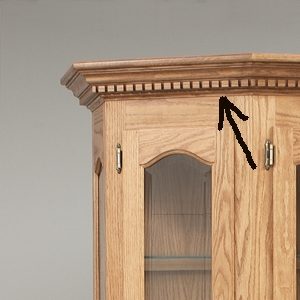
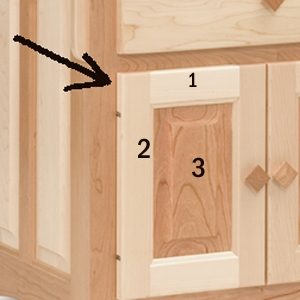

Shown is a photograph of the design on the top of the stile, which gives the door it’s name. Remember that any of these designs can have the center panel flat,raised panel or glass in the panel.



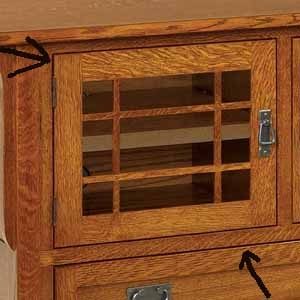 The inset, or flush mounted door (fig 31), sits inside the face frame.
The inset, or flush mounted door (fig 31), sits inside the face frame.
When you look at a side profile of the Amish Furniture the door will not stick outside the frame. This type of door is much harder to build for the Amish Craftsmen as the gap around the door must be cut precise for an exact fit. There must be enough room for the drawer to function, yet enough space to allow the wood to expand and contract with the weather. Many Amish Craftsmen build each door custom for that opening. Amish furniture with inset doors and drawers will command a higher price for the extra labor involved in custom work.
Tip:
Amish Craftsmen build their inset doors to custom fit each face frame.
If you remove doors make sure and label them so they get placed back in the correct order.
Pocket Doors:
Pocket doors are most often found on T.V entertainment centers built by Amish Craftsmen. This type of door is an inset type door that allows the door to be opened, then a set of rails mounted inside the case allows the door to slide inside. This hides the doors out of the way while watching TV.
Amish Furniture Craftsmen use solid wood doors and drawer fronts in their furniture. One way to tell if a drawer or door is solid wood is to look at the end grain of the piece. If the grain changes directions it may be a veneered board with a particleboard filler (fake).
There are two basic types of doors; the overlay door (fig 30) and the inset door (fig 31).
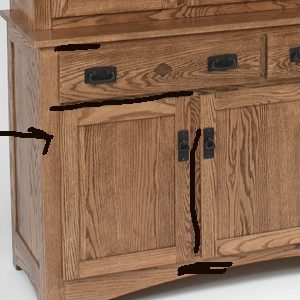

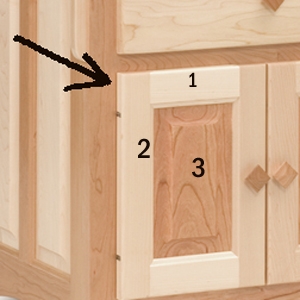 An overlay is identified by the door sitting outside the frame (fig 34).
An overlay is identified by the door sitting outside the frame (fig 34).
If you look at the furniture side profile, the door will be visible. Another factor in the overlay door is how much the door actually “overlay’s” the face frame. If you are having a custom piece of Amish furniture made this measurement is important to the Amish Craftsman.
Take a tape measure and get the distance both horizontally and vertically inside the face frame. Determine how much bigger the door is than the face frame and divide by 2, that is the amount of overlay on each side.
 Amish craftsmen use different doors and drawers to achieve the look and style needed for their quality furniture. Amish use solid wood in their drawers and drawer faces, along with quality hardware to last generations.
Amish craftsmen use different doors and drawers to achieve the look and style needed for their quality furniture. Amish use solid wood in their drawers and drawer faces, along with quality hardware to last generations.
Raised panel doors are very popular on Amish furniture. They are built using rails (fig 34 – #2) and styles (fig 34 – #1) cut to the correct width for the project. Amish craftsmen use a router to remove the outer edge of the center section, or center panel (fig 34 – #3), of wood. This gives the illusion that the center section is floating higher than the rails and styles giving the raised panel look.
Depending on the furniture style the rails and styles are also routered on the outside edge to add more detail to the door design. Most raised panel doors on Amish furniture are overlay doors and the Amish use hidden, adjustable hinges.
Shown in fig 34 is a raised panel door. The door is built from 5 different pieces of wood. The rails, or side pieces, identified by #2 is built from solid wood from a router bit that places a special groove in the wood for the panel to sit in (number 3).
The second pieces of wood are the rails, identified by #1 on the photo. This piece has the same groove cut into it, but the end pieces are cut to fit inside the groove from the rails. This gives a glue surface and ties the door pieces together.
Figure 102 shows the side profile of this door. Note how the center panel “floats” inside the rails and stiles. This is a precise cut that must be made by the Amish Craftsman. If the gap it too small the solid wood panel will crack and if it’s too large the panel will wiggle.
The center panel on fig. 102 has a profile cut around the edge by a router bit. This gives the illusion the panel is rising out of the door, thus the name of raised panel.
Flat Panel:
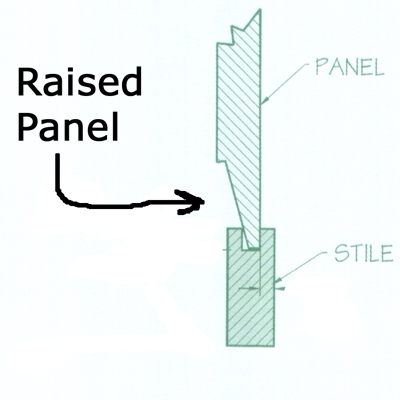 Flat panel doors have the mission style feel to them. The center panel is a solid piece of wood with the back of the panel routered out, or reversed. This makes the panel edge thinner so it will fit into the groove on the rails and styles. Often the rails and styles do not have a routered design profile. They are most often rounded edges. See the raised panel description which explains how the door is built.
Flat panel doors have the mission style feel to them. The center panel is a solid piece of wood with the back of the panel routered out, or reversed. This makes the panel edge thinner so it will fit into the groove on the rails and styles. Often the rails and styles do not have a routered design profile. They are most often rounded edges. See the raised panel description which explains how the door is built.
The panel in Fig 102 (raised panel profile above) would be “turned around” so the profile was on the inside of the door and the outside of the panel would be flat.
Smooth:
These doors are not used very often in Amish furniture. They are just one large piece of wood that has the edges routered. There are no rails and styles.